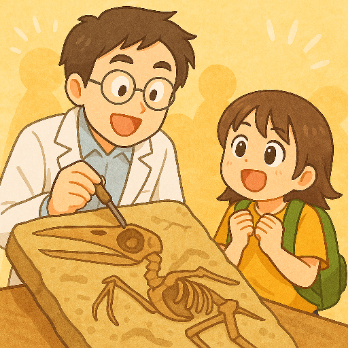🌐 This post includes an English version. Jump to English version
📰 ニュースまとめ
熊本県御船町から発見された翼竜の化石が、新属新種として「ニッポノプテルス・ミフネンシス」と命名されました。この化石は約9千万年前の後期白亜紀に属し、国内で発見された翼竜の学名が付けられたのは初めてのことです。発見は1996年に遡り、熊本大などの研究者によって確認されました。
💬 こんな会話が聞こえてきそうです
※以下のやりとりは記事をもとにしたフィクションです。
📝 管理人のひとこと
このニュースは、国内での化石研究の進展を示す重要な出来事です。新種の命名は研究者たちの努力の賜物であり、日本の恐竜研究の発展に寄与するものでしょう。また、こうした発見が若い世代に科学への興味を喚起するきっかけになることを期待しています。今後も日本国内での化石発見や研究が進むことで、さらなる知見が得られることを楽しみにしています。
この記事をシェアする:
🇬🇧 英語版を見る
Summary
A pterosaur fossil discovered in Mifune Town, Kumamoto Prefecture, has been named “Nipponopterus mifunenensis” as a new genus and species. This fossil dates back to the Late Cretaceous period, approximately 90 million years ago, and it is the first time a pterosaur found in Japan has been given a scientific name. The discovery dates back to 1996 and has been confirmed by researchers from Kumamoto University and others.
Dialogue
This dialogue is fictional and based on the article.
Researcher (Yoshida): Hello, Yamada. Did you hear about the new pterosaur fossil that was found in Mifune Town in the news recently?
Student (Yamada): Yes, I believe it was named “Nipponopterus mifuneensis.” It’s really fascinating!
Researcher (Yoshida): That’s right. This is the first time a pterosaur has been given a scientific name in Japan. It’s groundbreaking for names to be assigned to fossils found in the country.
Student (Yamada): And it’s from the late Cretaceous, about 90 million years ago, right? Just thinking about the diversity of life that existed in Japan during that time is so exciting!
Researcher (Yoshida): Absolutely, there’s so much we can learn from fossils, and they provide clues to understanding past ecosystems. I’m looking forward to the research ahead.
Student (Yamada): Yes, I want to learn more about pterosaurs. I hope I can get involved in research like this in the future!
Admin’s Note
This news marks an important milestone in the progress of fossil research in Japan. The naming of this new species is a testament to the researchers’ hard work and is expected to contribute to the advancement of dinosaur studies in the country. We also hope that such discoveries will inspire the younger generation’s interest in science. We look forward to more fossil discoveries and research in Japan, which will lead to further insights.



コメント